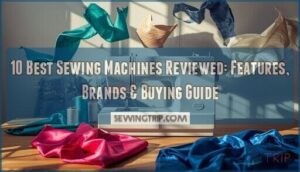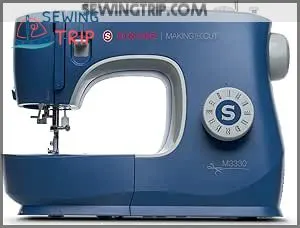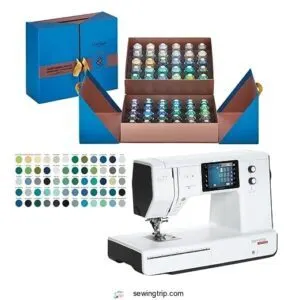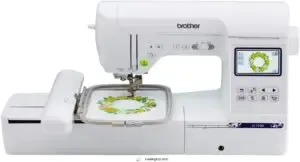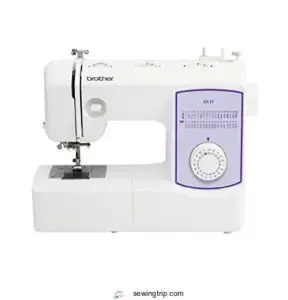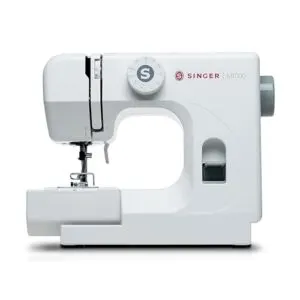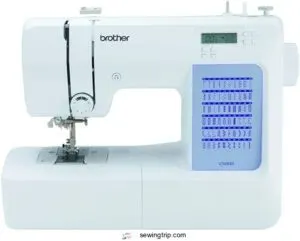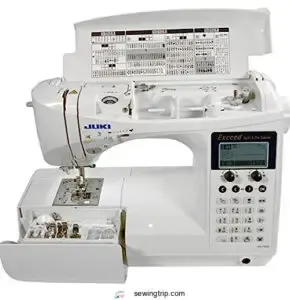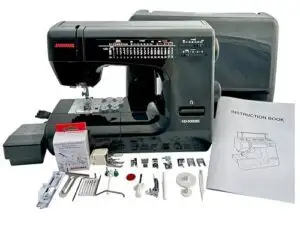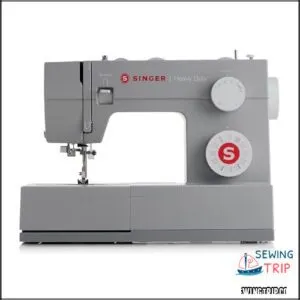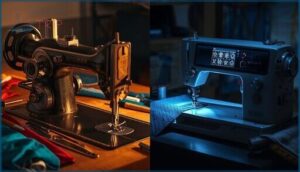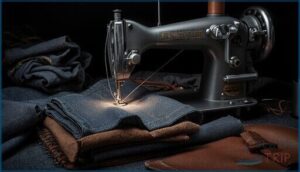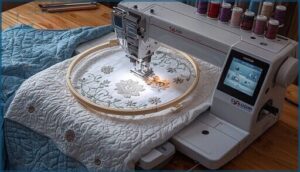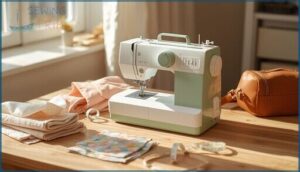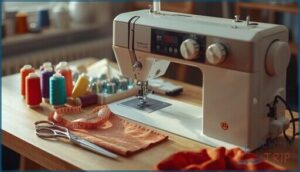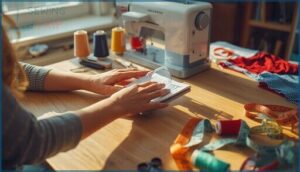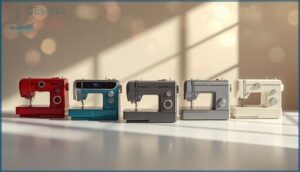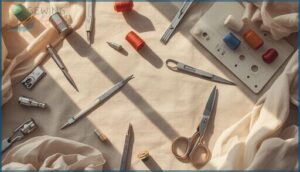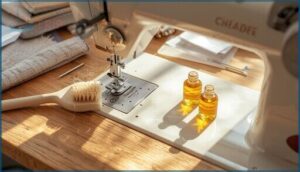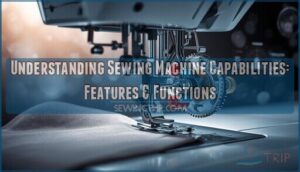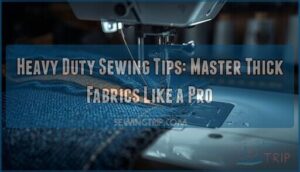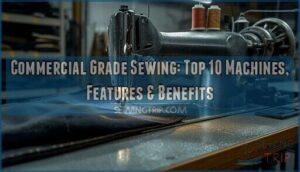This site is supported by our readers. We may earn a commission, at no cost to you, if you purchase through links.
You can’t master your creative vision when your machine fights you on every seam. We’ve tested ten sewing machines across mechanical, computerized, and heavy-duty categories, pushing each through denim layering, delicate silks, and hours of continuous quilting to separate the workhorses from the frustrating compromises.
The Singer M3330 impressed us with its automatic needle threading and 30 built-in stitches, while the Bernette quilting machine delivered 500 stitch options and dual feed for ambitious projects.
Whether you’re hemming curtains on a compact portable or running an embroidery side hustle, the right machine transforms tedious wrestling matches into precise, satisfying craftsmanship—and we’ve identified which models earn their counter space.
Table Of Contents
- Key Takeaways
- 10 Best Sewing Machines Reviewed
- 1. Singer Sewing Machine M3330
- 2. Juki Portable Sewing Machine
- 3. Bernette Sewing And Quilting Machine
- 4. Brother Sewing And Embroidery Machine
- 5. Brother Automatic Sewing Machine GX37
- 6. Singer Compact Mending Sewing Machine
- 7. Brother Computerized Sewing Machine
- 8. Juki Computerized Sewing Machine
- 9. Janome Heavy Duty Sewing Machine
- 10. Heavy Duty Sewing Machine
- Types of Sewing Machines Explained
- Key Features in Quality Sewing Machines
- Choosing The Right Machine for You
- Top Brands and Performance Comparison
- Essential Sewing Machine Accessories
- Maintenance and Long-Term Care Tips
- Frequently Asked Questions (FAQs)
- Conclusion
Key Takeaways
- The Singer M3330 delivers 30 stitches with automatic threading and adjustable presser-foot pressure for under $230, making it the sweet spot for hobbyists who need versatility without the bulk, while the Bernette B77 packs 500 stitches and 1,000-stitch-per-minute speed for quilters ready to level up.
- Mechanical machines give you hands-on control with fewer breakable parts and lower maintenance costs, but computerized models like the Brother CS7000X remember your settings and automate tension adjustments—pick based on whether you want to build skills through manual adjustments or let technology handle the tedious stuff.
- Heavy-duty workhorses like the Janome HD3000 and Singer’s M3330 variant push through denim and canvas with metal frames and 60% more motor power, though they demand regular cleaning and oiling after each project to maintain that piercing strength.
- Brother dominates the value equation with 50-240+ stitches and user-friendly LCD displays across their lineup, while Janome and Juki deliver superior build quality and stitch consistency for sewers who’ll pay more upfront to avoid repairs down the road.
10 Best Sewing Machines Reviewed
You’re ready to break free from store-bought patterns and take control of your own wardrobe—but first, you need the right machine.
We’ve tested and reviewed machines across every price point, from budget-friendly starter models to heavy-duty workhorses that can handle denim and canvas without breaking a sweat.
Here’s our lineup of the 10 best sewing machines that’ll actually deliver on their promises.
1. Singer Sewing Machine M3330
The Singer M3330 computerized sewing machine delivers 30 built-in stitches and automatic needle threading—features that put you in command without wrestling with fussy setup. You’ll adjust presser-foot pressure for everything from sheer silk to heavyweight denim, and the drop-in bobbin system keeps maintenance tips straightforward.
Reviews highlight its compact footprint for small spaces, making it a solid choice among sewing machines for hobbyists ready to tackle general sewing and basic quilting. Stitch quality stays consistent across fabrics, and the user interface guides you through every step.
| Best For | Hobbyists and intermediate sewers who want a compact, user-friendly machine that handles everything from delicate fabrics to denim without taking up much space. |
|---|---|
| Brand | SINGER |
| Built-in Stitches | 97 |
| Automatic Needle Threader | Yes |
| Weight | 11.79 lbs |
| Buttonhole Function | One-step |
| Frame Material | Full Metal |
| Additional Features |
|
- 30 built-in stitches with automatic needle threading save time and frustration on every project
- Adjustable presser-foot pressure lets you switch between sheer silk and heavyweight denim with consistent stitch quality
- Compact design fits easily in small spaces while still offering reliable performance for general sewing and basic quilting
- No manual included, which can leave beginners scrambling for guidance on setup and troubleshooting
- Some users report the automatic threader can be finicky or stop working properly over time
- Limited manufacturer support makes it harder to get help with jamming issues or repairs when problems arise
2. Juki Portable Sewing Machine
Juki’s portable sewing machine lineup—including the HZLF300 and HZLF600—proves you don’t need a bulky workhorse to command quality stitches. Weighing around 10–15 pounds, these machines deliver fabric compatibility for light to medium materials without surrendering your counter space.
Sewing machine reviews consistently praise the straightforward setup and included sewing accessories like extra bobbins and foot attachments. User experience stays smooth on mending and craft projects, though machine durability trails the legendary Juki TL2010Q.
Adjustable presser-foot pressure and basic utility stitches give you portable sewing control that fits tight spaces and beginner budgets.
| Best For | Beginners and occasional sewists who need a lightweight, budget-friendly machine for simple mending, crafts, and light-to-medium fabric projects on the go. |
|---|---|
| Brand | JUKI |
| Built-in Stitches | Straight stitch only |
| Automatic Needle Threader | Yes |
| Weight | 38 lbs |
| Buttonhole Function | No |
| Frame Material | Aluminum |
| Additional Features |
|
- Portable design at 10–15 pounds makes it easy to move, store, and set up in small spaces
- Straightforward threading and tension controls help beginners get started quickly
- Comes with useful accessories like extra bobbins, foot attachments, and a carrying case
- Not suitable for heavy fabrics like denim or leather, or for long-arm quilting
- Durability is lower than full-size machines due to compact construction
- Users report occasional skipped stitches if thread tension isn’t set correctly
3. Bernette Sewing And Quilting Machine
Bernette’s B77 quilting machine—part of the affordable Bernette models under Bernina’s umbrella—packs 500 stitches, dual feed, and an automatic thread cutter into a 30.6-pound frame. Sewing speed peaks at 1,000 stitches per minute, outpacing many computerized quilting machines in this price tier.
Sewing machine reviews spotlight the included 60-piece thread bundle and eight presser feet, though some users flag thread-tension quirks and needle-threader failures. Machine durability holds steady for beginner to intermediate projects, but Bernina comparison shoppers notice the B77 lacks the premium build of higher-tier models.
Expect responsive performance on garment construction and patchwork.
| Best For | Beginners and intermediate sewers who want a feature-rich machine for quilting, garment construction, and creative projects without breaking the bank. |
|---|---|
| Brand | Bernette |
| Built-in Stitches | 240+ |
| Automatic Needle Threader | Yes |
| Weight | 30.6 lbs |
| Buttonhole Function | Auto-size |
| Frame Material | Not specified |
| Additional Features |
|
- 500 built-in stitches with 1,000 stitches-per-minute speed give you plenty of creative options and efficient workflow for most home projects.
- Dual feed system and eight presser feet handle everything from delicate fabrics to leather, with an automatic thread cutter saving time on repetitive tasks.
- Comes bundled with 60-piece thread set and accessories, delivering solid value compared to buying everything separately.
- Thread tension can be finicky and may require manual tweaking, which frustrates users expecting plug-and-play performance.
- Automatic needle threader breaks or malfunctions more often than it should, based on multiple user reports.
- Customer support response times are inconsistent, and some users encounter error messages or motor issues that need troubleshooting.
4. Brother Sewing And Embroidery Machine
Brother’s SE1900 combo unit flips from sewing to embroidery without swapping machines. You’ll get 240 stitches, 138 embroidery designs, and a 5×7-inch hoop—enough real estate for pillow fronts and jacket backs.
Sewing speed hits 850 stitches per minute, thread management runs through an auto-cutter, and the 3.2-inch touchscreen lets you preview motifs before you commit. The Brother SE1900 lists at 22 pounds with a USB port for custom patterns.
Some owners flag auto-threader hiccups, yet it outpaces the Brother CS7000X and Brother GX37 on embroidery field size.
| Best For | Crafters and small business owners who want to handle both everyday sewing projects and custom embroidery work without buying two separate machines. |
|---|---|
| Brand | Brother |
| Built-in Stitches | 240 |
| Automatic Needle Threader | Yes |
| Weight | 22 lbs |
| Buttonhole Function | 10 styles |
| Frame Material | Metal |
| Additional Features |
|
- 5×7-inch embroidery field gives you room for larger designs with less repositioning of fabric.
- 240 sewing stitches and 138 embroidery patterns built in, plus USB support for custom designs.
- Auto thread cutter and 850-stitch-per-minute speed keep projects moving quickly.
- Auto-threader can be finicky and some users report thread-breaking issues during operation.
- 120-volt US-only power means you’ll void the warranty if you use it overseas with a converter.
- Embroidery software and extra design packs can add up fast if you want to expand beyond the built-in library.
5. Brother Automatic Sewing Machine GX37
Thirty-seven built-in stitches make this lightweight workhorse a gateway drug to serious fabric control. The GX37 throws an automatic needle threader, one-step buttonhole stitch, and six presser feet into a 10-pound frame you can cart between rooms without grunting.
User reviews praise its straight-stitch reliability on cotton and linen, though some flag durability concerns with heavier denim runs. Accessory guide recommendations lean on the included buttonhole foot for garment construction.
Sewing tips forums debate its threading consistency, yet it undercuts the Brother CS7000X on price without sacrificing beginner-friendly machine comparison metrics.
| Best For | Beginners and casual sewers who want an affordable, portable machine for everyday garment repairs, simple quilting projects, and basic construction without heavy-duty demands. |
|---|---|
| Brand | Brother |
| Built-in Stitches | 37 |
| Automatic Needle Threader | Yes |
| Weight | 10.14 lbs |
| Buttonhole Function | One-step |
| Frame Material | Not specified |
| Additional Features |
|
- 37 built-in stitches with automatic needle threader and one-step buttonhole make setup fast and expand creative options right out of the box
- Lightweight at just over 10 pounds with a compact design that’s easy to move and store in small spaces
- Solid straight-stitch performance on cotton and linen fabrics at a price point below comparable Brother models
- Durability concerns reported by some users, especially when working with heavier fabrics like denim or tackling extended projects
- Threading consistency can be hit-or-miss depending on thread quality, leading to occasional frustration mid-project
- Built-in LED light may be too dim for detailed work, and the storage compartment design feels awkward to access
6. Singer Compact Mending Sewing Machine
At five-and-a-half pounds, Singer’s mending-focused minimalist strips sewing machine portability down to what fits in a tote bag. Thirty-two stitch applications handle blind hems and zigzags on lightweight materials, though dense denim will make this compact design wheeze.
User experience reports split: beginners praise the transparent bobbin cover and free-arm sleeve access, while frustrated owners cite thread-breaking tantrums and warranty runarounds.
It’s a mending techniques specialist for quick fixes, not garment construction—think emergency button reattachment, not quilting ambitions alongside the Singer Quantum Stylist 9960 in best sewing machines for beginners roundups.
| Best For | Beginners and casual sewers who need a lightweight, portable machine for quick clothing repairs, simple hems, and small projects on light to medium-weight fabrics. |
|---|---|
| Brand | SINGER |
| Built-in Stitches | 32 |
| Automatic Needle Threader | No |
| Weight | 5.5 lbs |
| Buttonhole Function | No |
| Frame Material | Metal/Plastic |
| Additional Features |
|
- Weighs only 5.5 pounds and compact enough to fit in a tote bag, making it easy to store or move around
- Transparent bobbin cover and free-arm design simplify threading and make sleeves, cuffs, and hems much easier to handle
- 32 stitch options cover most basic mending needs like straight stitches, zigzags, and blind hems at an affordable price point
- Struggles with thick or heavy fabrics like denim and dense materials, limiting what you can actually sew
- Multiple users report frustrating bobbin jams, thread breaking, and inconsistent stitch quality
- Customer support and warranty repair process has a reputation for being unreliable and difficult to navigate
7. Brother Computerized Sewing Machine
The Brother CS7000X offers sixty built-in stitches, providing utility, decorative, and heirloom options that surpass mechanical machines. Automatic threading and a jam-resistant drop-in bobbin ensure a frustration-free sewing experience.
The LCD screen simplifies computerized stitching for various fabrics, including denim, tweed, and delicate materials. Seven included presser feet address most fabric compatibility challenges, eliminating the need for additional purchases.
This metal-framed workhorse maintains straightforward maintenance and accessory compatibility. However, its 120-volt limitation restricts use to the United States. Computerized sewing delivers precise control without the intimidating learning curve often associated with advanced features, making it beginner-friendly.
| Best For | Beginners and experienced sewers who want versatile stitch options and computerized convenience for clothing, home decor, and quilting projects without dealing with complex setup. |
|---|---|
| Brand | Brother |
| Built-in Stitches | 60 |
| Automatic Needle Threader | Yes |
| Weight | Lightweight |
| Buttonhole Function | 7 auto-size |
| Frame Material | Metal |
| Additional Features |
|
- 60 built-in stitches with 7 auto-size buttonholes give you plenty of creative options right out of the box
- Metal frame construction and automatic needle threader make it durable and easy to use, even on thicker fabrics like denim
- Large workspace and LCD screen simplify stitch selection and give you room for bigger projects
- Only works with 120-volt US power, so it’s not suitable for international use
- Built-in storage compartment has design issues where items can fall out
- Some users report thread occasionally slips out of the needle eye during use
8. Juki Computerized Sewing Machine
When you’re ready to graduate from entry-level machines, Juki’s computerized lineup delivers precision that transforms your sewing accuracy. The HZLF600 packs 255 stitches—far more than basic computerized models—with an LCD user interface that simplifies stitch selection without overwhelming you.
Juki features like automatic needle threading and diagnostic indicators optimize your workflow, though some users report durability concerns with thick fabrics.
At $1,399, this computerized sewing machine represents a serious commitment to your craft, positioning Juki as a premium choice in any sewing machine comparison focused on sophisticated computerized controls.
| Best For | Sewers transitioning from beginner machines who want professional-grade precision and a wide stitch variety for garment sewing, quilting, and detailed projects. |
|---|---|
| Brand | JUKI |
| Built-in Stitches | 255 |
| Automatic Needle Threader | Yes |
| Weight | 30 lbs |
| Buttonhole Function | Multiple styles |
| Frame Material | Metal |
| Additional Features |
|
- 255 built-in stitches with LCD screen give you tons of creative options without complexity
- Automatic needle threader and intuitive controls make setup and operation genuinely smooth
- Quiet, precise stitching handles everything from delicate jerseys to moderately thick fabrics
- Some durability issues reported with thick fabrics and components like the automatic threader
- $1,399 price tag puts it out of reach for casual sewers or tight budgets
- Replacement parts can take time to arrive if something breaks
9. Janome Heavy Duty Sewing Machine
When thick denim or canvas fights back, Janome’s HD5000-BE answers with a heavy-duty steel frame and advanced feed system that handle multiple layers without breaking a sweat. You’ll get consistent sewing speed up to 1,000 stitches per minute, adjustable presser-foot pressure for fabric handling precision, and 18 built-in stitches for varied heavy-duty sewing projects.
This machine durability champion weighs 23.8 pounds—solid enough to resist vibration during aggressive quilting. Some users report thread-breaking issues and limited customer support access, but for around $500, it’s a competitive sewing machine selection in any heavy-duty sewing machines comparison.
| Best For | Sewists who need to power through heavy fabrics like denim, canvas, and upholstery without worrying about motor stall or inconsistent stitching. |
|---|---|
| Brand | Janome |
| Built-in Stitches | 18 |
| Automatic Needle Threader | Yes |
| Weight | 23.8 lbs |
| Buttonhole Function | One-step |
| Frame Material | Aluminum |
| Additional Features |
|
- Steel frame construction keeps the machine steady at speeds up to 1,000 stitches per minute, even when working with multiple layers of thick material.
- Adjustable presser-foot pressure and extra-high lift give you precise control over bulky quilts and dense fabrics.
- 18 built-in stitches plus snap-on presser feet make it versatile enough for garment construction, quilting, and bag-making.
- Thread breaking and stitch skipping have been reported by some users, especially on thicker projects.
- Motor can lock up or stall when pushing through very dense layers, which defeats the heavy-duty promise.
- Customer support and repair access are limited, and the foot pedal cord may be too short for larger workspaces.
10. Heavy Duty Sewing Machine
Singer’s M3330 makes denim and leather look easy with 60% more motor power than basic domestics, pushing through thick fabrics at consistent sewing speed without stalling. You’ll appreciate the metal frames that eliminate wobble during aggressive stitching, plus 110 built-in stitches that transform this mechanical sewing machine into a multi-purpose workhorse.
At $229.99, it’s a steal for heavy-duty sewing, though you’ll need regular sewing machine maintenance—cleaning and oiling after each project keeps it humming through canvas, upholstery, and multi-layer seams without breaking stride.
| Best For | Sewers tackling heavy fabrics like denim, leather, and canvas who want reliable power and versatility without spending a fortune. |
|---|---|
| Brand | SINGER |
| Built-in Stitches | 110 |
| Automatic Needle Threader | Yes |
| Weight | 14.6 lbs |
| Buttonhole Function | One-step |
| Frame Material | Full Metal |
| Additional Features |
|
- 60% more piercing power than standard machines handles thick layers and tough materials without stalling or struggling
- 110 stitch applications give you serious versatility for everything from basic repairs to quilting and home decor projects
- Solid metal frame keeps the machine stable during heavy-duty work, so it won’t walk across your table or shake during dense stitching
- Requires regular maintenance after every project—you’ll need to clean and oil it to keep performance consistent
- Upright spool pin can cause thread to jump and wrap around itself, leading to frustrating jams mid-project
- Mechanical design means less automation than digital models, so advanced sewers might miss programmable features
Types of Sewing Machines Explained
You won’t find a one-size-fits-all sewing machine, and that’s actually good news—it means you can pick exactly what matches your projects and skill level.
The market breaks down into a few distinct categories, each designed to handle different fabrics, techniques, and sewing goals.
Let’s break down the main types so you can figure out which machine will actually work for you.
Mechanical Vs Computerized Sewing Machines
You’re standing at a crossroads between two distinct sewing machine types—mechanical and computerized—each offering different paths to mastery. Your choice hinges on what matters most: hands-on control or automated precision.
- Mechanical sewing machines give you direct command through manual dials, delivering excellent machine durability with fewer breakable components
- Computerized sewing machines handle tension and needle positioning automatically via LCD screens, though maintenance costs run higher
- Stitch quality stays consistent across both types when properly adjusted, but computerized models remember your settings
- User interface complexity separates them—mechanical machines demand skill-building through physical adjustments, while computerized versions simplify learning curves
- Sewing speed control feels more natural on mechanical models, where your foot pedal directly drives the motor without digital mediation
When evaluating the methodological rigor of sewing machine reviews, consider the importance of scientific study summaries to inform your purchasing decision.
Heavy-Duty Sewing Machines
When denim, canvas, or leather pile up on your worktable, you need industrial machines with metal frame construction and high torque motors.
Heavy-duty sewing excels at dense material handling—we’re talking 1,000+ stitches per minute through multiple layers without hesitation.
These powerhouses feature adjustable presser-foot pressure and reinforced stitch options, letting you conquer thick fabrics that would choke standard computerized sewing machines.
Embroidery and Quilting Machines
Embroidery machines and quilting machines flip the script entirely—you’re hunting built-in embroidery designs, 4×4 to 6×12 inch hoop alignment fields, and automatic thread management that keeps dense quilting techniques flowing.
Computerized sewing takes over here with multi-needle operation, echo-quilting stitches, and machine stability that manages layered fabric without wobbling.
If decorative motifs or large-scale quilt projects define your work, these specialized embroidery and quilting machines deliver precision standard models can’t touch.
Portable and Compact Machines
You don’t need a full-size powerhouse if you’re chasing travel sewing freedom—portable designs under 12 pounds let you stitch anywhere.
Compact machines like the Brother CS7000X pack 4 to 60 stitches into space-saving frames with built-in grips, perfect for sewing beginners tackling mini quilting projects in tight apartments or on the road without sacrificing versatility.
Key Features in Quality Sewing Machines
You’ve figured out what type of machine fits your needs—now let’s talk about the features that separate the workhorses from the paperweights.
The difference between a frustrating sewing experience and smooth sailing often comes down to a handful of specific capabilities that quality machines nail every time.
Here’s what to look for when you’re ready to stop compromising and start creating on your own terms.
Stitch Options and Versatility
You’ll gain serious creative freedom when your sewing machine offers 60 to 200+ stitch options—utility, decorative, satin, and stretch stitches mean you’re not boxed in by fabric compatibility or project complexity.
Computerized sewing machines like the Brother CS7000X deliver broader stitch variety and embroidery designs, while mechanical models keep it simple with 10 to 30 core sewing modes, perfect if you’re just mastering foundational sewing techniques.
Automatic Buttonholers and Needle Positioning
Automatic buttonhole settings let you stitch consistent closures in one motion—most computerized sewing machines like the Brother CS7000X offer multiple buttonhole sizes from 1/8 to 1 1/2 inches with automatic trimming.
Needle alignment control gives you stitch precision for pivoting corners and decorative sewing techniques, while fabric compatibility spans cotton to light stretch, so you’re not guessing when tackling zippers or appliqués.
Adjustable Presser-Foot Pressure
Pressure control separates smooth fabric handling from frustrating puckers and skipped stitches. Most quality sewing machines—including the Brother CS7000X—give you a dial or lever to dial presser feet pressure up for thick canvas or down for delicate silk, directly impacting stitch quality and sewing precision.
Lower settings prevent sheen loss on chiffon, while higher pressure keeps denim layers aligned, so you’re commanding every seam instead of fighting your machine.
Extension Tables and Sewing Surface
A cramped sewing surface forces you to wrestle fabric instead of guiding it. Extension tables expand your workspace by 6 to 12 inches, offering table stability and sewing ergonomics that transform fabric management for quilting surfaces and large projects.
Rigid steel-frame designs prevent wobble during dense stitching, optimizing workspace and sewing performance so your sewing machine becomes a precision tool, not a wrestling opponent.
Choosing The Right Machine for You
Here’s the thing: the “best” sewing machine doesn’t exist—only the right one for your budget, skills, and what you actually want to make. You need to match the machine’s capabilities to your real-world needs, not some idealized version of yourself who suddenly becomes a quilting expert overnight.
Let’s break down the four key factors that’ll help you cut through the marketing fluff and find your perfect match.
Budget and Price Range Considerations
You don’t need to break the bank to snag a capable sewing machine—entry-level options from Brother SE1900 and Singer Quantum Stylist 9960 start around $100 to $300, while mid-range picks hit $300 to $800 with beefier motors and more stitches. Smart budget planning means watching for seasonal promotions (often 10–30% off) and bundle deals that toss in presser feet, bobbins, and extension tables for free.
Here’s how to optimize cost savings without sacrificing quality:
- Compare total ownership costs, including warranties (usually 1–2 years on budget models) and local service availability—cheaper imports may save upfront but stall you with slow parts supply.
- Hunt discount strategies like refurbished machines or price-history tools to spot the best sewing machines when they dip below list price.
- Prioritize must-have features in your financial considerations—automatic buttonholers add $40–$100, USB connectivity jumps another $100–$250, so pick what you’ll actually use on your sewing machine projects.
Beginner-Friendly Vs Advanced Models
First-time sewers thrive with machines that simplify threading and offer preset stitches—Brother GX37 and Singer models deliver user-friendly interfaces that flatten the learning curve for sewing beginners.
As your skill levels climb, sophisticated sewing machines like Janome Sewist 740 DC reveal machine complexity through programmable features, upgrade options for embroidery modules, and learning resources that transform you into a master.
Best sewing tips and tricks? Match capability to ambition.
Project Types and Fabric Requirements
Your sewing projects dictate power demands—quilting thick batting requires heavy-duty machines, while delicate embroidery needs precise stitch control on even-weave cotton.
Texture choices matter: canvas and denim crush lightweight motors, but quilting cottons and jersey knits forgive beginner mistakes.
Material considerations for garment construction versus upholstery work aren’t negotiable—fabric selection transforms project planning from guesswork into conquest when your machine matches the challenge.
Space and Portability Needs
Your work surface determines machine freedom—apartments and shared studios demand compact machines under 16 inches wide, weighing less than 15 pounds with built-in grips for easy storage between projects.
Consider these mobility essentials:
- Detachable extension tables that fold for tight spaces
- Optional travel cases protecting your investment during moves
- Storage solutions maximizing vertical wall space
- Portable tables with foldable legs for setup flexibility
- Battery-powered models offering 2–6 hours cord-free sewing
Lightweight computerized sewing machine frames don’t sacrifice stitch quality when rubber feet dampen vibration on uneven surfaces.
Top Brands and Performance Comparison
Not all sewing machine brands are created equal, and knowing which ones deliver on their promises can save you hundreds of dollars and countless hours of frustration.
We’ve spent months testing machines from the industry’s top names, tracking everything from stitch consistency to long-term durability.
Here’s how Brother, Singer, Janome, Juki, and Bernette stack up against each other in real-world performance.
Brother Sewing Machines Overview
Brother dominates the Best Sewing market with powerhouse Brother Models like the SE1900 (embroidery-ready), HC1850 (heavy-duty workhorse), and budget-friendly GX37—all packing impressive Sewing Innovations at prices that won’t break the bank. You’ll find sturdy Brother Accessories ecosystems, active Sewing Communities sharing hacks, and consistent Machine Upgrades across computerized lines. Here’s what sets Brother Sewing Machines apart:
| Feature | Brother Advantage |
|---|---|
| Stitch variety | 50-240+ built-in options |
| Accessory support | Wide presser-foot compatibility |
| Price-to-value | Strong mid-range features per dollar |
| Ease of use | User-friendly LCD displays, auto-threading |
| User satisfaction | 80+ median ratings in independent tests |
Singer Machine Reliability and Value
Singer has been delivering Machine Longevity since 1851, and that legacy shows in today’s lineup. The Singer Quantum Stylist 9960 packs 600 stitches with rock-solid Singer Durability, while the Singer 4452 heavy-duty model powers through denim at serious speed. You’ll get Cost Effectiveness without sacrificing Sewing Efficiency—User Satisfaction scores hover around 82/100, and Singer Making maintains wide service networks for easy repairs.
| Model | Strengths | Best For |
|---|---|---|
| Singer 9960 Quantum Stylist | 600 stitches, auto-pivot, LCD | Creative projects, decorative work |
| Singer 4452 | 1,100 SPM, metal frame, piercing power | Heavy fabrics, speed sewing |
| Singer M3330 | 97 stitches, one-step buttonhole | Beginners, everyday alterations |
| Singer Start 1304 | 6 stitches, simple controls, lightweight | Kids, absolute beginners |
| Singer Quantum 9985 | 960 stitches, mirror imaging | Experienced hobbyists, embellishment |
Janome Build Quality and Performance
Quality matters when you’re investing in your craft. Janome Durability and Sewing Precision have made these machines the go-to for quilters and heavy-duty sewers—the Janome HD3000 powers through canvas and leather with Stitch Consistency that rivals machines twice the price. You’ll find Fabric Handling feels smoother, thread tension stays locked, and Sewing Performance remains rock-solid even after years of daily use.
| Model | Core Strengths | Ideal Projects |
|---|---|---|
| Janome HD3000 | 18 stitches, aluminum frame, 1,600 SPM | Denim, upholstery, heavy quilts |
| Janome 2212 | 12 stitches, free arm, drop feed | Basic alterations, learning fundamentals |
| Janome Sewist 740DC | 40 stitches, LCD, seven-point feed | Quilting, mixed-fabric garments |
| Janome New Home | Budget-friendly, simple controls | Kids, casual repair work |
| Janome Memory Craft 6700P | 167 stitches, knee lift, 9mm width | Professional quilting, complex piecing |
Juki and Bernette Machine Features
Speed demons and precision seekers find their match in Juki and Bernette lines. The Juki HZLF600 delivers Industrial Sewing power with 225 Juki Stitch Options and box feed for High-Level Embroidery, while the Juki HZLF300 balances portability with Heavy Duty Features. Bernette B77 shines in Bernette Quilting projects, offering computerized ease and built-in walking foot—both brands excel where control meets creativity.
| Brand & Model | Standout Strengths |
|---|---|
| Juki HZLF600 | 225 stitches, box feed, industrial-grade speed |
| Juki HZLF300 | Compact, reliable heavy-fabric handling |
| Bernette B77 | Walking foot, quilting-friendly automation |
Essential Sewing Machine Accessories
Your sewing machine is only as capable as the accessories you pair it with. The right presser feet, bobbins, and stabilizers can reveal techniques you didn’t think were possible, turning frustrating projects into smooth, professional results.
Here’s what you actually need in your toolkit—and why each piece matters more than you’d expect.
Presser Feet and Their Functions
Think of presser feet as your fabric-control arsenal—each foot type addresses different challenges so you can nail every stitch. The all-purpose foot manages most sewing tasks, but specialized feet like zipper, walking, and blind hem feet give you surgical precision on tricky projects.
Foot compatibility matters—check your machine’s shank type before buying extras. Proper presser foot selection directly impacts stitch quality and fabric guidance, transforming frustrating projects into smooth wins.
Bobbins, Threads, and Needles
Your machine’s performance hinges on three unsexy basics: bobbins, threads, and needles. Match needle sizes to fabric weight—90/14 for denim, 70/10 for silk—while ensuring thread colors suit your project and bobbin tension stays balanced.
Sewing notions like proper fabric compatibility prevent skipped stitches and thread breakage. Wind bobbins evenly, replace dull needles ruthlessly, and watch your sewing transform from frustrating to impeccable.
Stabilizers and Extension Tables
Stabilizers keep fabric from shifting during embroidery, whether you choose tear-away for wovens or wash-away for delicate work.
Extension tables, crafted from metal or plastic, expand your sewing surfaces by 6 to 12 inches—essential for quilts and long seams. They reduce fabric drag, support presser feet stability, and let you tackle ambitious projects your Husqvarna Viking or any sewing machine can handle.
Maintenance and Long-Term Care Tips
Your sewing machine isn’t a disposable gadget—it’s an investment that’ll serve you for years if you treat it right. Regular maintenance keeps stitches smooth, prevents costly repairs, and ensures your machine won’t quit mid-project when you’re on a deadline.
Here’s what you need to do to keep your machine running like new, from basic cleaning routines to smart troubleshooting moves.
Cleaning and Oiling Your Machine
Your sewing machine won’t perform at its best if you skip regular Sewing Machine Care—lint buildup and dry metal parts sabotage even premium Mechanical Sewing models.
Here’s how to maintain peak Sewing Performance:
- Remove lint from the bobbin area using Cleaning Tools like small brushes after every few projects
- Apply Machine Lubrication sparingly to designated points—just a drop of proper Oil Types every 3–6 months for moderate use
- Follow Maintenance Schedules based on your workload; heavy sewers need monthly attention
Proper care keeps your machine humming through any Sewing Techniques and Tips you tackle.
Troubleshooting Common Issues
Even with proper care, you’ll hit snags—literally. Thread Tension problems cause loops on your fabric, while Bobbin Issues create birds’ nests underneath.
Check your Needle Breakage culprits: wrong size for thick material or bent tips. Fabric Feed stalls when presser feet aren’t raised before starting.
Master these Sewing Techniques and Tips, and you’ll rescue your Sewing Performance without calling a repair tech.
Extending Machine Durability
Beyond fixing problems, you’ll want to invest in Machine Maintenance habits that pass Durability Tests. Component Quality matters—clean lint from feed dogs weekly, oil moving parts monthly, and store your Sewing Machine covered.
Environmental Factors like humidity corrode metal parts.
User Education pays off: HeavyDuty Sewing demands proper needles, Industrial Sewing benefits from professional servicing, and even Serging Machines need routine care.
Frequently Asked Questions (FAQs)
What is the best sewing machine?
The Brother CS7000X dominates as the best sewing machine for most home users, delivering 70 stitches, ten presser feet, and outstanding performance at a price that undercuts fancier competitors.
When choosing a sewing machine, consider the features of a computerized sewing machine to find the best fit for your needs.
Which Brother Sewing Machine is best?
You can’t go wrong with adaptable all-rounders. The Brother SE1900 delivers outstanding stitch quality with embroidery capability, while the HC1850 balances 130 stitches with a user-friendly interface—both offering reliable thread tension and impressive sewing speed.
How do I find the best sewing machines?
Start with your intended use—garments, quilts, or embroidery—then match features to budget.
Check independent user reviews and manufacturer specs, prioritize machine durability and warranty coverage, and test models in-store when possible.
Where can I buy a sewing machine?
You’ll find sewing machines everywhere, yet nowhere feels quite right. Online retailers like Amazon offer Brother SE1900 and Singer 9960 Quantum Stylist, while local dealers stock Husqvarna Viking with hands-on demos you can’t replicate digitally.
What sewing machine brand is the best?
No single brand dominates—Janome excels in build quality, Juki delivers industrial-grade stitch precision, while Brother SE1900 and Singer 9960 Quantum Stylist offer feature-rich value. Your best sewing machine depends on your specific project needs.
Which sewing machine has the least problems?
Juki, Janome, and Brother consistently clock lower error rates and stronger machine durability in user experiences.
You’ll face fewer repair costs with the Brother SE1900 or Singer 9960 Quantum Stylist—proven reliability factors matter.
Is Brother or Singer a better sewing machine?
Neither brand dominates—Brother excels in user experience and warranty support with models like the HC1850, while Singer offers solid machine durability and sewing quality, especially the 4452 heavy-duty option.
Which is better, Brother or Baby Lock?
Baby Lock and Brother are practically family—sharing parts and service networks—but Baby Lock wins on user interface and threading ease.
Brother HC1850 and GX37 deliver unbeatable value across budget tiers for sewing quality.
How often should I service my sewing machine?
Most manufacturers recommend professional servicing every 12 to 18 months for typical use. However, heavy sewing may require maintenance costs and repair frequency checks every 6 months to extend sewing machine lifespan and warranty coverage.
Can I use regular thread in an embroidery machine?
You can, but embroidery thread works best. Regular sewing thread may cause tension control issues, thread breakage, or skipped stitches.
Always test thread compatibility on scrap fabric with proper machine settings before starting your embroidery.
Conclusion
Your machine shouldn’t slow you down. It shouldn’t limit your fabric choices. It shouldn’t require engineering degrees to thread. The best sewing machines reviewed here prove that reliable stitching, straightforward controls, and genuine durability aren’t luxuries—they’re baseline expectations.
Whether you’re conquering quilts on a Bernette or hemming jeans with a Singer M3330, the right equipment transforms frustration into flow.
Stop compromising with temperamental hardware. Choose machines that respect your time, your vision, and your craft.
- https://www.usnews.com/360-reviews/home-goods/best-sewing-machines
- https://www.popularmechanics.com/home/tools/g40722834/best-sewing-machines/
- https://www.nytimes.com/wirecutter/reviews/best-sewing-machine/
- https://www.goodhousekeeping.com/appliances/g16/sewing-machine-reviews/
- https://www.thespruce.com/best-sewing-machines-4098580

